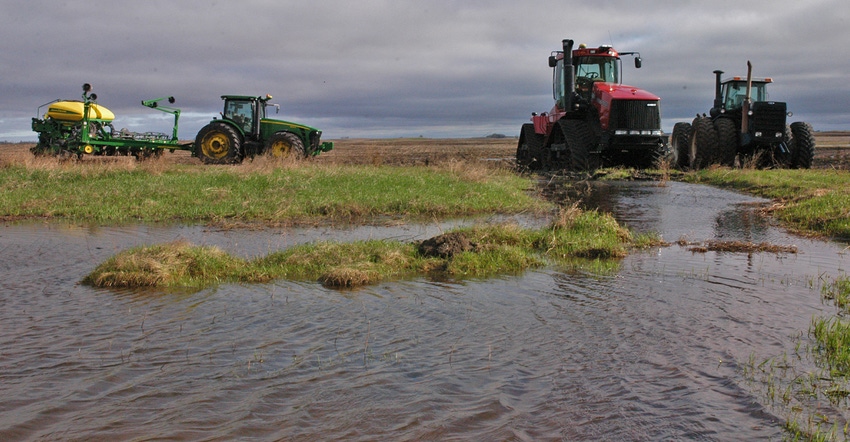December 2, 2019

Because fields were wet through the fall, chances are high they will be wet in the spring, too. Ruth Beck, South Dakota State University Extension agronomist, compiled these tips on planning for a wet spring:
1. Consider seeding a cover or forage crop in lieu of a cool-season grain crop. It is possible to grow two forage crops in one season in most areas. There may be situations where this is preferable to switching to corn, soybeans or sunflowers. Careful consideration is necessary when crop rotation changes are being made. Changing the rotation can have consequences for several years due to impacts on residue levels and weed, disease, and insect management programs.
2. Aim for the ideal planting window. In South Dakota, the ideal planting window for spring wheat, oats and peas is thought to be the first three weeks of April or earlier if planting conditions are favorable. Spring wheat, oats and peas are all cool season crops that will germinate at lower soil temperatures (35-40 degrees F) and can survive moderate frost at early stages of growth. Planting these crops as early as possible promotes plant development before the warmer period of the summer. Heat and water stress can negatively impact yield of these crops, especially if this occurs during pollination and grain fill.
Yield data from research on spring wheat suggests that wheat loses 1.5% of its yield potential every day after the optimum planting date. However, situations where there is ample moisture at seeding might temper this negative response, especially if cool weather prevails during the early summer. An option for spring wheat is to “dormant seed” it in the very late fall (around Thanksgiving). Dormant seeding spring wheat provides producers with a viable option for getting spring wheat planted and avoiding sloppy spring field conditions.
3. Plant early-season varieties. Earlier varieties can improve the chance of avoiding mid and late summer heat during sensitive growth stages.
4. Increase spring wheat planting rates if planting is delayed. A heavier planting rate is generally recommended to compensate for reduced tiller development.
5. If planting is delayed consider planting earlier maturity corn. Soil temperatures of 50 degrees are usually what is required for corn to germinate. Corn that does not receive the required heat to mature properly will result in a product with low test weight, poor quality and increased drying costs. Producers should be proactive by working with seed dealers to select corn varieties with a range of maturities. This will help reduce risk.
6. Select appropriate soybean maturity for the planting date. Soybeans require 54-degree soil temperatures for germination. If drying conditions prevail this spring and soybean planting is timely, selecting a soybean variety with the appropriate maturity rating for the growing area provides the best chance to achieve the highest yield.
In South Dakota, if planting dates for soybeans are delayed past mid-June, the maturity rating for soybean seed should be reduced by 0.5 from normal. A further reduction in maturity rating may be required if planting date is delayed until early July.
Soybean maturity is daylength sensitive, which makes this crop a better option for late planted areas. However, producers may also need to reevaluate. Crops like milo, soybeans, sunflowers and possibly even flax may be better options when planting is delayed.
7. Check with your crop insurance agent for planting date deadlines.
Source: SDSU, which is solely responsible for the information provided and is wholly owned by the source. Informa Business Media and all its subsidiaries are not responsible for any of the content contained in this information asset.
You May Also Like




